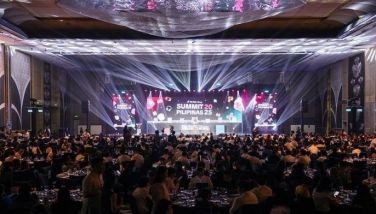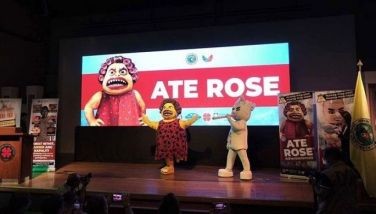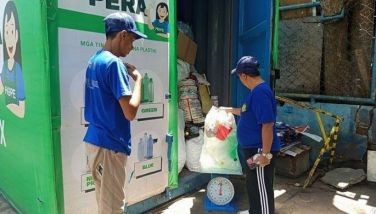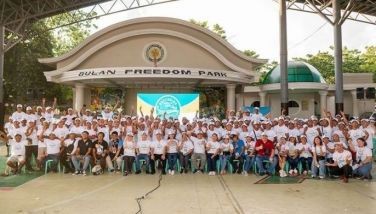When SAM met Natasha
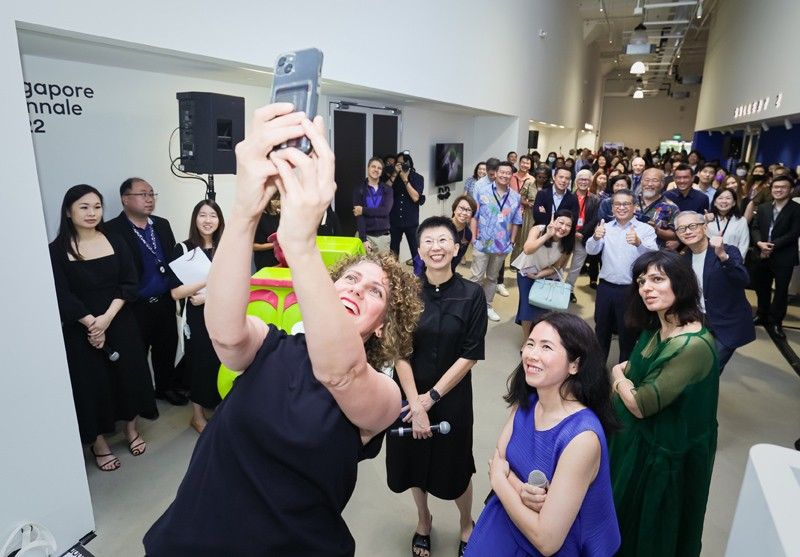
‘Serious play’ at Singapore Biennale
SINGAPORE — A pair of shaggy, vaguely technological totems, bedecked in artificial straw and tiny bells, stand in one room of Singapore Art Museum (SAM), which accommodates much of this year’s Singapore Biennale, aka SB2022, aka “Natasha.”
They look like towering AC/DC outlets, with male plugs and female sockets, but they’re on wheels and covered in layers of matting with arrangements of fake fruit on each of their crowns. This is Haegue Yang’s “The Hybrid Intermediates – Flourishing Electrophorus Duo,” made especially for SB2022.
Yang’s piece encapsulates, in some ways, the non-theme theme of SB2022. In naming it “Natasha,” the four co-artistic directors —all women, comprising June Yap, Binna Choi, Nida Ghouse and Ala Younis— perhaps hoped to deflect definitions, to decentralize the very idea of SB, make it more interactive and immersive, while also addressing concerns of the post-pandemic world.
Yang’s two towers (“Sonic Intermediate – Hairy Carbonous Dweller” and “The Randing Intermediate – Furless Uncolored Dweller”) don’t just stand there: they’re wheeled around the gallery floor by art attendants during the activation, gently tinkling and fluttering slightly in the surrounding air. Kitschy by design (that artificial straw! that fake fruit! those plugs!), Yang wanted to overlap the modern and technical with something more shamanistic, linked to folk culture and its relationship to the cosmos.
Welcome to the post-pandemic world, as expressed in Singapore, a hive of hypermodernity and state-subsidized cultural messaging.
Despite the decentralizing and deflecting, the collections at SAM are the nerve center — the brain, if you like — of SB2022, which is also spread outward among Singapore’s southern islands (Sentosa Cove, St. John’s, Lazarus) and sprinkled throughout the city-state’s parks and public spaces. Even the touristy Singapore Flyer is splashed with art: one premium capsule (serving Singapore Slings) is decorated with greenery, exotic birds and a looped video in an immersive piece by Ranu Mukherjee called “Ensemble for Non-Linear Time.” That piece was not exactly curated, but arranged by art collective AWKNDAFFR (the young Wayne Lim and Soh Kay Min), whose “Islandwide Coverage” sites also dot Singapore Biennale this year, which launched Oct. 16 and runs until March 19, 2023.
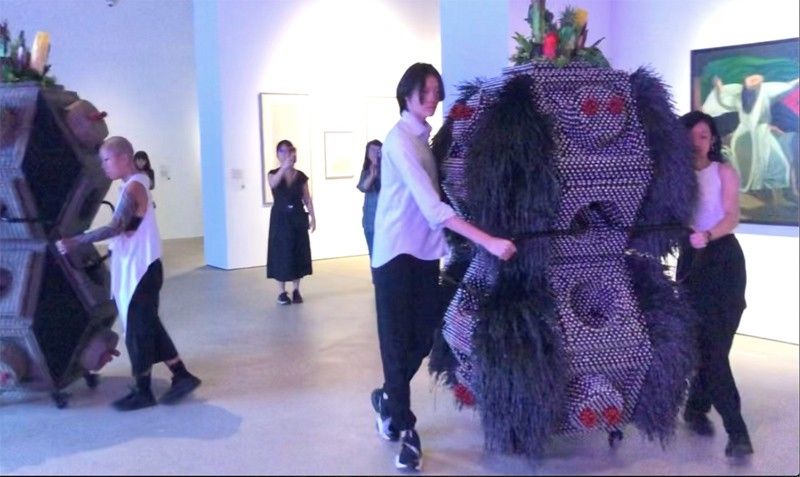
Yang’s towers are something that much of the Biennale work shies away from being: outwardly playful, even while being serious. It’s not a lighthearted Biennale, by any stretch, though it invites human interaction after two years in isolation. For SB co-curator and SAM Curatorial & Collections director June Yap, it’s a matter of “serious play.” This Biennale “is more playful in raising the questions,” such as where we are in 2022, after a life-altering, world-changing lockdown. She says the “worst thing after post-pandemic is to go back to exactly how we were. That means we haven’t learned anything.”
On Day 1, we visit SAM, nestled amid port cranes and shipping containers at Tanjong Pagar Distripark. Much of the first and fifth levels have been transformed into “Natasha,” the space that is also a name, and a name in search of a meaning. Nomenclature is a creative act, and the four co-directors fully intend and hope that visitors to SB2022 will supply their own “identity” of Natasha.
The four started trading ideas online over a year ago, while the world was still in lockdown, meeting up in recent months. There was little conflict or debate; each had their lists of possible artists and how their statements fed into a developing theme (or non-theme).
What emerges is a confluence of expressions that take on a lot of feminine themes — oppression, suppression, sexual identity, economic identity — but, even more universally, human struggles: displacement, connection with and disconnection from nature; time, erosion, mortality. There is a dedication to layering, to weaving in cultural mythology and personal histography. There is an underlying focus on where we are now, post-pandemic, and what it means to move forward. How does art help us do that? How does it explain or illuminate where we are? How does it place us back into the environment around us, the world at large? And how are we different?
A sample of works:
• “Tales in Stone: In Search of the Language of Primordial Paradise” by ?South Korea’s Shin Beomsun positions stones around SAM, viewable with magnifying glasses that also fracture time (with a video lag): the “petroglyphs” carry natural striations into which the collaborators have inscribed imaginary meaning: mythologies that may have arisen from the images and patterns engraved on the stones; a world-forming act in itself.
• Joo Jaehwan’s series of bricolage paintings are assemblages of materials from the veteran South Korean artist’s studio, balancing textural reflection and analysis with wit and — yes — “playful” results.
• Cambodian artist Kanitha Tith uses found materials, wire-woven sculptures and a recreation of her childhood home setting (complete with ref, monobloc chairs and TV showing vintage videos) to construct a personal history that is both nostalgic and forwardly expressive in the works “Someone is Moving” and “Hut Tep Soda Chan (Hut of an Angel).”
Similarly, Elina Waege Mikalsen, coming from the northern Sápmi peoples of Norway, uses traditional Sámi weaving to summon not just stories from her family history through vibrant intertwined threads, but a linking of mythological storytelling motifs of fire and darkness to the cosmos and the present.
• Thai artist Araya Rasdjarmrearnsook loved her dog so much that, when it died, she constructed moving tributes in three works — “Afterwards, regret rises in our memory even for bygone hardship II” (2017), “Philosophical Theater of Animals” (2019) and “Dogs’ Palatial House (2022) — each examining binary relationships between life and death, object and self, and animal to human. (And which one is the owner?)
• Video and digital artist Firas Shehadeh grew up in a Saudi Arabia refugee camp where online chat and use of imagery was subject to algorithmic censorship. His display of digital collages on aluminium (“Signal Feels Collision”) is an attempt to defeat the algorithms through strategic rearrangement of online-sourced images, something he says he learned from hip-hop sampling and filmmakers like Jean Luc Godard. (Later, he performed a DJ set for the SAM opening night, radically rearranging sampled sounds.)
• Natasha Tontey’s “Garden Amidst the Flame - Lacuna for Compassion” recreates Indonesian warrior rituals in an eye-catching performance installation that positions women in a central role.
• Singapore artist Ong Kian Peng spent three months in Jordan filming “The Viscous Sea,” an immersive installation of six video screens building to a view of the Dead Sea, gradually losing its water levels due to corporate siphoning and damming. Sinkholes pock the earth; the end result, the artist posits, will be a sludgy ball of salty material, something non-sustaining to life, but perhaps a transitory point to something else. A human dancer flickers through the dying space of his videos, eventually floating eerily amid drone-shot views of the Dead Sea and its surrounding landscapes.
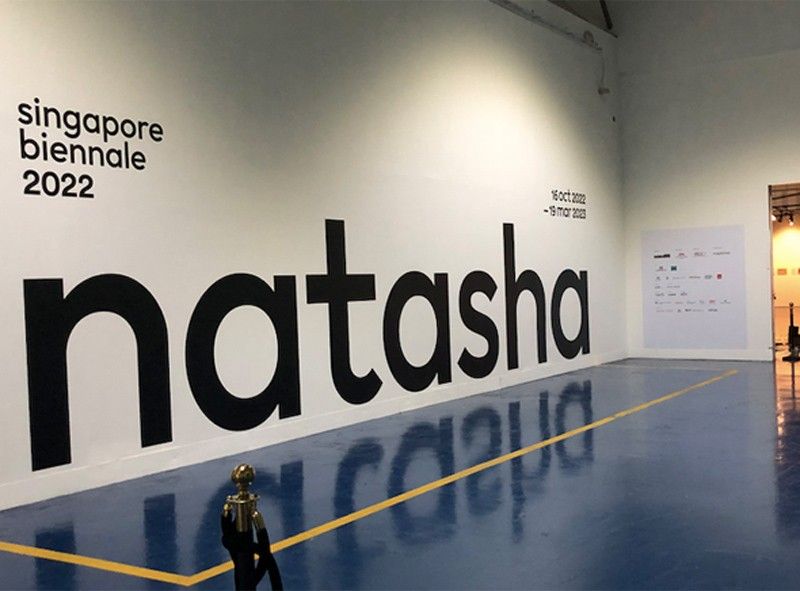
• A large wall-mounted tapestry is decaying, seemingly before our eyes. It’s Hemali Bhuta’s “My pulse is beating and my veins throbbing and in wonder, my song bursts forth,” layered with lac wax, a shiny resin excreted from queen lac bugs before they die; it’s used to make shellac, a commercial product for rendering human googaws and porch decks shiny, but co-director Nida Ghouse bids us to examine the buried economic exchanges (the “materiality and value chain”) behind every object we purchase or prize or even lay eyes upon; the hidden economies behind our digital world are also a theme in the work of Indian artist Aarti Sunder (“Ghost Cut – Some Clear Pixels Amongst Many Black Boxes”) which traces back our pathways in a digital space at different scales of empowerment and involvement; as well as Elaine W. Ho’s video installation “The Last Emporium,” which speculates on our future development through dialogue with an AI chat device.
The next day, we visit Sentosa Cove — once a quarantine site during the 1918 pandemic — where a cargo terminal is repurposed as a “Visitor Centre.” But inside, visitors find themselves plunged into Maile Meyer and Drew Kahu‘aina Broderick’s “KI?PUKA” (“Natasha”), playfully dislocating us to the artists’ Hawaiian origins, its emphasis on community and earth. We hop on a ferry to St. Lazarus, where speaker systems at the dock narrate weather reports and conditions from over 100 years ago, when weather was first charted; these emanations are linked back to the SAM space, where ?Moad Mushabi’s installation (“Air Cut Into Song”) places long-range antennae picking up transistor radio signals before a video screen giving us live feeds of the St. Lazarus dock — a wonderful loop exchange between weather, earth, and our place within the system.
Visitors usually venture to the well-manicured islets islands for fun and picnics, but during SB2022, they’re likely to “encounter” art unexpectedly. At least that’s the hope of co-curator Ala Younis, who likes the idea of art being placed here as a contemplative “intervention,” not a destination itself.
Similarly, other SAM exhibits are sprinkled throughout St. John’s island and downtown Singapore, such as the “Nina bell F. House Museum” project, in which South Korean artist Donghwan Kam, working with The Netherlands’ Casco Art Institute, deploys tiny houses containing jars of fermenting soy sauce, a metaphor for household product, food as commerce as well as connection, and maybe a way of reclaiming the idea of “home” as a safe space from domestic turmoil, notes co-curator Binna Choi. (The “Nina” and “bell” are for African-American activists Nina Simone and bell hooks, and “F” for radical feminist Silvia Federici.) Then there’s Trevor Yeung’s “The Pavilion of Regret,” a small greenhouse installed at Yan Kit Playfield downtown: observing that Singaporeans now spend less time indoors caring for their houseplants since the pandemic ended, the Hong Kong artist set up a public exchange program to drop off old plants in a public space, or pick up new ones. He says it was a commentary on how we process “our regrets” by sometimes shedding them somewhere, hoping the next one who comes along will take care of them.
So what’s in a name? Natasha takes us on an interconnected, interwoven journey through Singapore, leading us back, again and again, to ourselves.
* * *
Visit singaporebiennale.org/visitor-info for schedules and ticketing information on Singapore Biennale 2022, which runs until March 23, 2023.














